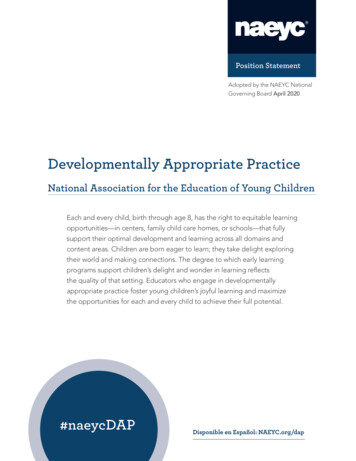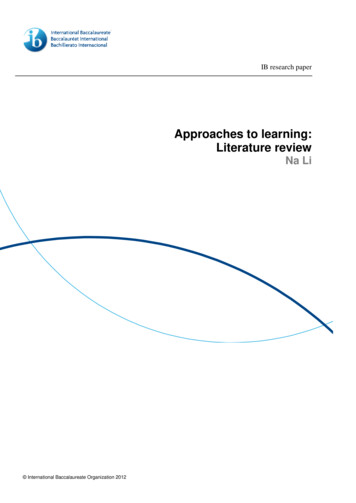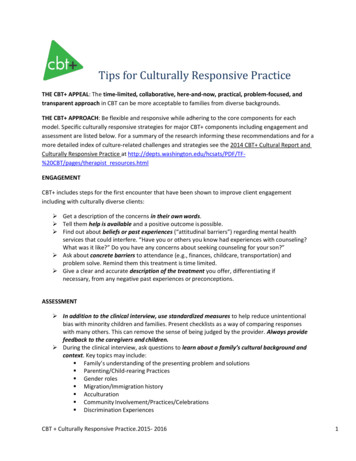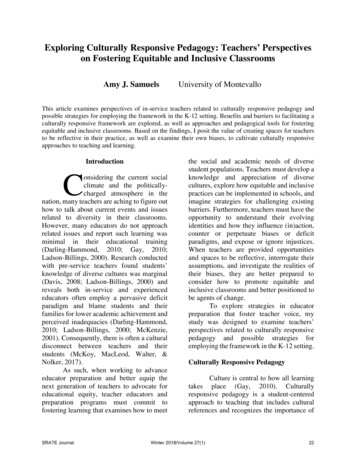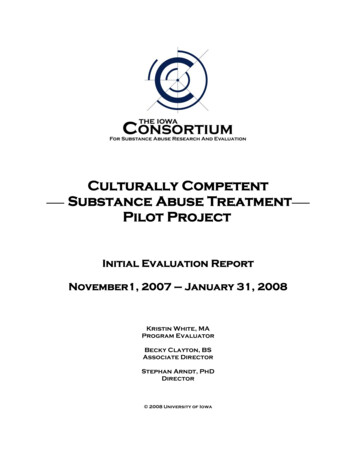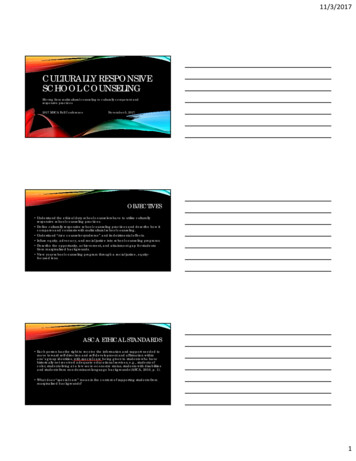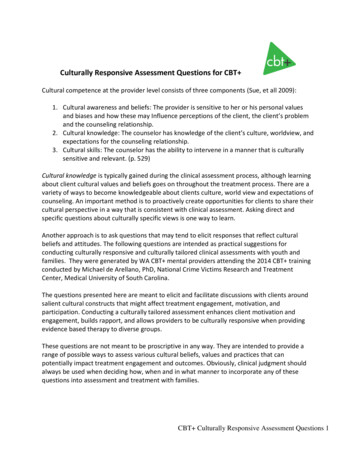
Transcription
Effective Culturally and Developmentally Appropriate Practices toSupport Early LearningMarch 24, 2021 WebinarSupplementThe Program for Infant and Toddler Care (PITC)Recommends these 10 Keys to Culturally Sensitive CareKey #1‐ Cultural ConsistencyInfants‐ Have the same educator care for the infant from birth through 18 months. if possible, evenin your infant classroom, age range may only go to 12 months. It would benefit the infant to havethe educator follow the infant to another classroom as they transition to another classroom.Toddlers‐ Post pictures of their families, where they live, and their favorite food.Key #2‐ Work Toward Representative StaffingInfants‐ Hire staff that are representative of the children and speak the same language, if possible.Toddlers‐ Post pictures of staff who work in the program that are representative of the childrenserved.The Source for Learning, Inc.www.sflece.org
Key #3‐ Create Small GroupsInfants‐ Have small educator‐child ratio which allows to meet the needs of infants. 1‐2 or 1‐3 ratiosare better educator‐child ratios.Toddlers‐ if the number of toddlers cannot be reduced in a classroom then group toddlers in smallnumbers in the same classroom.Key #4‐ Use the Child’s Home LanguageInfants‐ Sing lullabies that are familiar to the infant in their native language, if possible.Toddlers‐ Use rhymes and songs that are familiar to toddlers and related to their culture.Key #5‐ Make Environments RelevantInfants‐ Attempt to create an atmosphere that is similar to the infant’s home environment. Ask theinfant’s family about their nap environment at home.Toddlers‐ Use holiday decorations and describe words that relate to their holiday. Add props in theclassroom that may be similar to their home.The Source for Learning, Inc.www.sflece.org
Key #6‐ Uncover Your Cultural BeliefsInfants‐ Reflect on your cultural roots related to child‐care practices. Compare and how they differfrom the families you serve. It’s important to be aware because they may differ.Toddlers‐ Ask families the words or phrases that capture their cultural beliefs. Reflect on those andthink of ways to incorporate some beliefs into your classroom.Key #7‐ Be Open to the Perspectives of OthersInfants‐ Consider conversations with families about their childrearing practices and reflect on yourown. Compare the similarities and differences and determine a healthy junction.Toddlers‐ Offer children’s books from different racial and ethnic cultures and point out thedifferences with positive comments and acceptance.Key #8‐ Seek Out Cultural and Family InformationInfants‐ Consider creating documents that gathers cultural information about families.Toddlers‐ Learn what are the three most important things for each family you serve. Keep a journaland reflect on ways to incorporate their priorities into your classroom environment, schedule, andtransitions.The Source for Learning, Inc.www.sflece.org
Key #9‐ Clarify ValuesInfants‐ Offer opportunities for continuous conversations with families about what they valuerelated to their infant.Toddlers‐ Inquire with families about cultural approaches on social and emotional issues whileworking with toddlers and consider sharing approaches that you may use in the classroom.Key #10‐ Negotiate Cultural ConflictsInfants‐ At times of miscommunication, be persistent to mend the relationship and consider whatwould be the best approach; developmentally, professionally, and culturally for the infant.Toddlers‐ Negotiate with the intent of valuing the families’ perspective and your knowledge aboutdevelopmentally appropriate practices and quality child‐care.The Source for Learning, Inc.www.sflece.org
Effective Culturally and Developmentally Appropriate Practices toSupport Early LearningMarch 24, 2021 WebinarSupplementMulticultural children’s Games & Music Resources:Cultural Games https://www.parents.com/search/?q games from around the world ound‐the‐world/ https://www.incultureparent.com/?s 5 board games from around the worldMusic turalism.htm ids.aspx cal Instruments �kids/ https://www.teaching.com.au/search?action search&q multicultural instrumentsMulticultural Children’s Books:General Beyond the Great Mountains: A Visual Poem About China, Ed Young, Chronicle Books Cuckoo, Cucu’, Lois Ehlert, Scholastic Books Children Just Like Me: A unique celebration of children around the world, Barnabas and AnabelKindersley, DK Publishing, INC Wake Up, World! A Day in the Life of Children Around the World, Beatrice Hollyer, Henry Holtand Company Mixed: A Colorful Story, Arree Chung, MacmilliaThe Source for Learning, Inc.www.sflece.org
Variety of Cultures Raven – A trickster tale from the Pacific Northwest, Gerald McDermott, Scholastic The Woman Who Outshone the Sun, Alejandro Cruz Martinez, Scholastic Where is Gah‐ning? Robert Munsch, Annick Press Abiyoyo, Pete Seeger, Scholastic The Hole in the Dike, Norma Green, Scholastic Three Samurai Cats, Eric Kimmel, Scholastic Just Plain Fancy, Patricia Polacco, Dell Publishing There is a Flower at the Tip of My Nose Smelling Me, Alice Walker, Harper Collins Amazing Grace, Mary Hoffman and Caroline Binch, Scholastic Boundless Grace, Mary Hoffman and Caroline Binch, ScholasticSelfFamilies My Family, Your Family, Kindergarten Children, Westfield School, Modern Curriculum Press We Are All Alike .We Are All Different ., Cheltenham Elementary Kindergarten, Scholastic The Relatives Came, Cynthia Rylant, Aladdin BooksFood Related Strega Nona Meets her Match, Tomie dePaola, G.P. Putnam’s Sons Too Many Tamales Gary Soto and Ed Martinez Putnam Potluck Anne Shelby Orchard Books Latkes and Applesauce Fran Manushkin ScholasticHolidays Chicken Sunday, Patricia Polacco, Scholastic A Jewish Holiday ABC, Malka Drucker and Rita Pocock, Trumpet Club The Trees off the Dancing Goats, Patricia Polacco, Trumpet ClubThe Source for Learning, Inc.www.sflece.org
The Program for Infant and Toddler Care (PITC) Recommends these 10 Keys to Culturally Sensitive Care Key #1‐ Cultural Consistency Infants‐ Have the same educator care for the infant from birth through 18 months. if possible, even in your infant classroom, age range may only go to 12 months.

